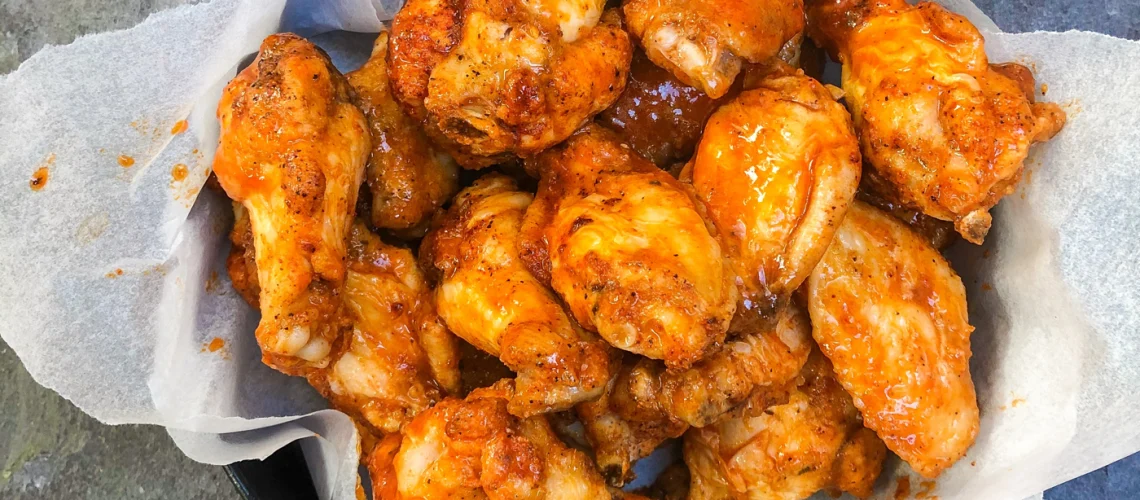Chicken wings are a delicious dish enjoyed worldwide. From game day feasts to family dinners, these small yet flavorful pieces of poultry have captured the hearts of many.
This article covers everything you need to know if you love chicken wings but want to eat healthy. We cover the calorie and protein content of 10 chicken wings, offering a comprehensive look at how they fit into your diet.
Nutritional Overview of 10 Chicken Wings
The nutritional content of chicken wings varies, influenced by cooking methods, seasoning, and serving sizes. Let’s take a look at the calorie and protein content of 10 chicken wings, considering different preparation styles.
| Preparation Style | Calories (per 10 wings) | Protein (per 10 wings) |
| Deep-Fried with Sauce | 1640 | 60-68g |
| Plain, Baked | 690 | 60-68g |
| Average | 1165 | 60-68g |
Deep-fried wings, especially when coated in sauce, are significantly higher in calories. This increase is due to the frying process and adding calorie-dense sauces. The protein content is generally the same, regardless of how you prepare them, although breading them may result in some additional protein.
On average, consuming ten chicken wings will provide around 1165 calories and 60-68 grams of protein. It’s important to remember that these figures can fluctuate based on the size of the wings and specific preparation methods.
Impact of Cooking Methods: Fried vs. Grilled
The cooking method used to cook chicken wings significantly influences their nutritional content. The primary difference lies in the calorie and fat content, which varies between frying and grilling.
| Cooking Method | Calories (per 10 wings) | Protein (per 10 wings) | Fat (per 10 wings) |
| Fried | 1640 | 60-68g | 100g |
| Grilled | 850 | 60-68g | 40g |
- Fried Chicken Wings:
- Higher in calories and fat due to the oil absorption during the frying process.
- The crispy texture often comes at the cost of additional calories.
- Grilled Chicken Wings:
- Lower in calories and fat, making them a healthier alternative.
- Grilling offers a different flavor profile.
Health Considerations
- Fried Wings:
- High in saturated fats, potentially impacting heart health if consumed in excess.
- Suitable for occasional indulgence rather than regular consumption.
- Grilled Wings:
- A healthier choice for frequent consumption.
- Better aligns with diets focusing on high protein and lower fat intake.
Sauce Selection: Nutritional Information
The choice of sauce can dramatically alter the nutritional value of chicken wings. Here’s a look at some popular sauces:
| Sauce Type | Calories (per serving) | Protein (per serving) | Sugar (per serving) |
| Buffalo | 50 | 0.2g | 0.2g |
| BBQ | 60 | 0g | 12g |
| Teriyaki | 70 | 1g | 14g |
- Buffalo Sauce:
- Low in calories and sugar, it is a tangy and spicy option that doesn’t significantly increase calorie count.
- BBQ Sauce:
- Higher in sugar, contributing to additional calories.
- Teriyaki Sauce:
- High in sugar, adding more calories. It’s also higher in protein than other sauces.
How Sauces Affect Nutritional Value
- Calorie Addition: Sauces can add significant calories, especially sugary ones.
- Flavor vs. Health: Balancing taste preferences with health considerations is key.
- Portion Control: Moderation in sauce usage can help manage calorie intake.
Ranch and Bleu Cheese: A Nutritional Perspective
Dips like ranch and bleu cheese are popular accompaniments for chicken wings, but they also add to the meal’s overall calorie and fat content. Here’s a breakdown:
| Dip Type | Calories (per 2 tbsp) | Protein (per 2 tbsp) | Fat (per 2 tbsp) |
| Ranch | 140 | 1g | 14g |
| Bleu Cheese | 150 | 2g | 15g |
- Ranch Dip:
- High in calories and fat, primarily from cream and mayonnaise.
- Bleu Cheese Dip:
- Similar in calorie and fat content to ranch, with a slightly higher protein due to the cheese.
Impact on Nutritional Profile
- Calorie Addition: Both dips significantly increase the calorie content of a chicken wing meal.
- Fat Content: High in saturated fats, which can impact heart health if consumed frequently.
- Portion Control: Limiting dip portions can help manage overall calorie and fat intake.
Healthier Alternatives and Tips
For those looking to enjoy chicken wings in a healthier way, consider these alternatives and tips:
- Baked or Grilled Wings: Opt for baking or grilling instead of frying to reduce calorie and fat intake.
- Homemade Sauces: Create your sauces with less sugar and healthier ingredients.
- Vegetable Sides: Serve wings with vegetables to balance the meal.
- Moderation in Dipping: Use dips sparingly or choose lower-calorie alternatives like Greek yogurt-based dips.
Final Thoughts on Chicken Wing Protein and Calorie Count
Chicken wings, a beloved dish worldwide, can vary greatly in their nutritional content based on preparation methods, sauces, and dips. Understanding these differences is key to enjoying this delicious food in a way that aligns with your health goals. Remember, moderation is crucial, and making informed choices about cooking methods, sauces, and accompaniments can significantly impact the nutritional value of your meal. Enjoy your chicken wings, but do so mindfully, balancing indulgence with health-conscious decisions.
If you’re in the Colorado area, give our menu a look for chicken wings and other delicious food. If you’d rather make the food yourself, we also have a bulk grocery delivery service.

